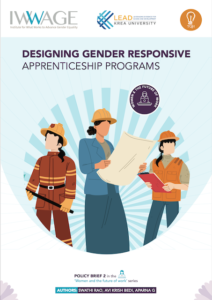Authors: Swathi Rao, Avi Krish Bedi, Aparna G
Published: September 2023
 It is widely known that women’s labour force participation in India needs policy attention. Although 66.8% women in India are in the working age, their labour force participation rate stands at a mere 35.6%, compared to men (81.8%); and their employment is mostly confined to the informal sector.
It is widely known that women’s labour force participation in India needs policy attention. Although 66.8% women in India are in the working age, their labour force participation rate stands at a mere 35.6%, compared to men (81.8%); and their employment is mostly confined to the informal sector.
Skill development is an important lever for increasing female labour force participation and meeting the targets set by the United Nations Sustainable Development Goals (SDGs) of full and productive employment and decent work. However, skilling without the means to transition to an occupation cannot enhance economic prospects for women. Apprenticeships, therefore, offer the right mix of job relevant skill training with a career pathway.
In the context of the future of work, apprenticeships, and specifically quality apprenticeships, can improve the employability of youth and adults by skilling, reskilling, and upskilling, regardless of age or gender. They can also assist governments in keeping the learning systems contemporaneous with the job market. From a gender lens, apprenticeships become even more important, given that they not only promise technical skills to women, they also are a means for participants to get life skills and a sense of agency needed for more permanent employment.
Government initiatives like the National Apprenticeship Promotion Scheme (NAPS) and the National Apprentice Training Scheme (NATS) aim to enhance skill development and employment prospects. However, a marked gender imbalance persists in these programs, with the majority of apprentices being male. This underscores the urgent need for reforms to establish gender-inclusive apprenticeship programs in India.
To address these gaps, this brief proposes several recommendations:
-
- Firstly, collecting gender-disaggregated data can provide insights into women’s choices and open new avenues for their participation.
- Secondly, incentivizing employers to hire more female apprentices and offering additional allowances can stimulate greater female engagement.
- Thirdly, targeted awareness campaigns for women can enhance understanding and interest in apprenticeship programs.
- Fourthly, creating gender-sensitive infrastructure and challenging social norms inhibiting female participation will foster inclusivity.
- Finally, integrating NAPS into the DESHStack portal can improve women’s access to employment opportunities and streamline their entry into the labour market.
Implementing these recommendations promises a more gender-inclusive apprenticeship system, fostering economic growth and prosperity for women.
Read the full brief on Gender Responsive Apprenticeship Schemes here.
